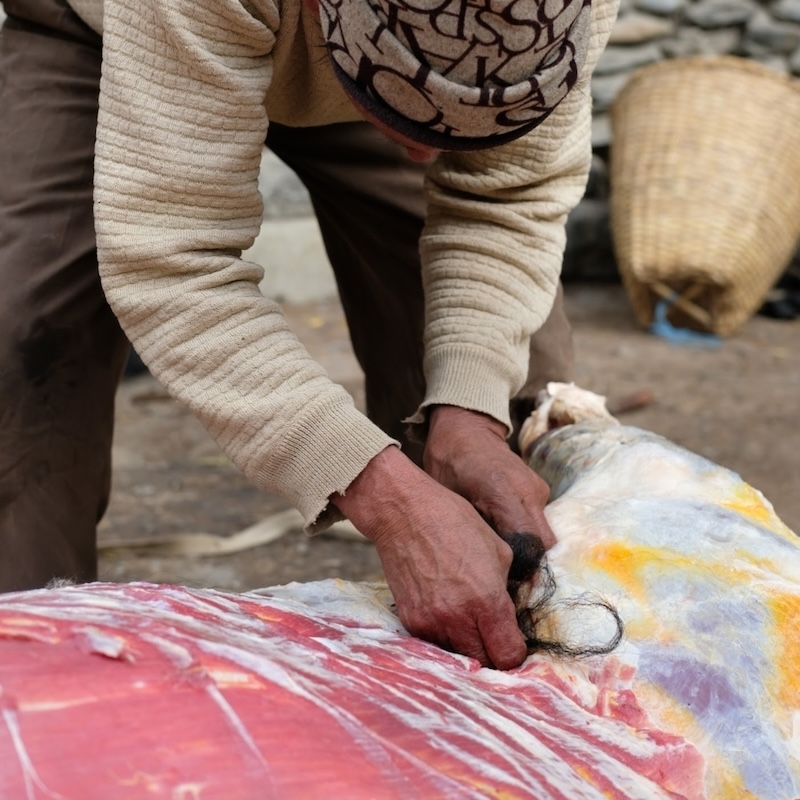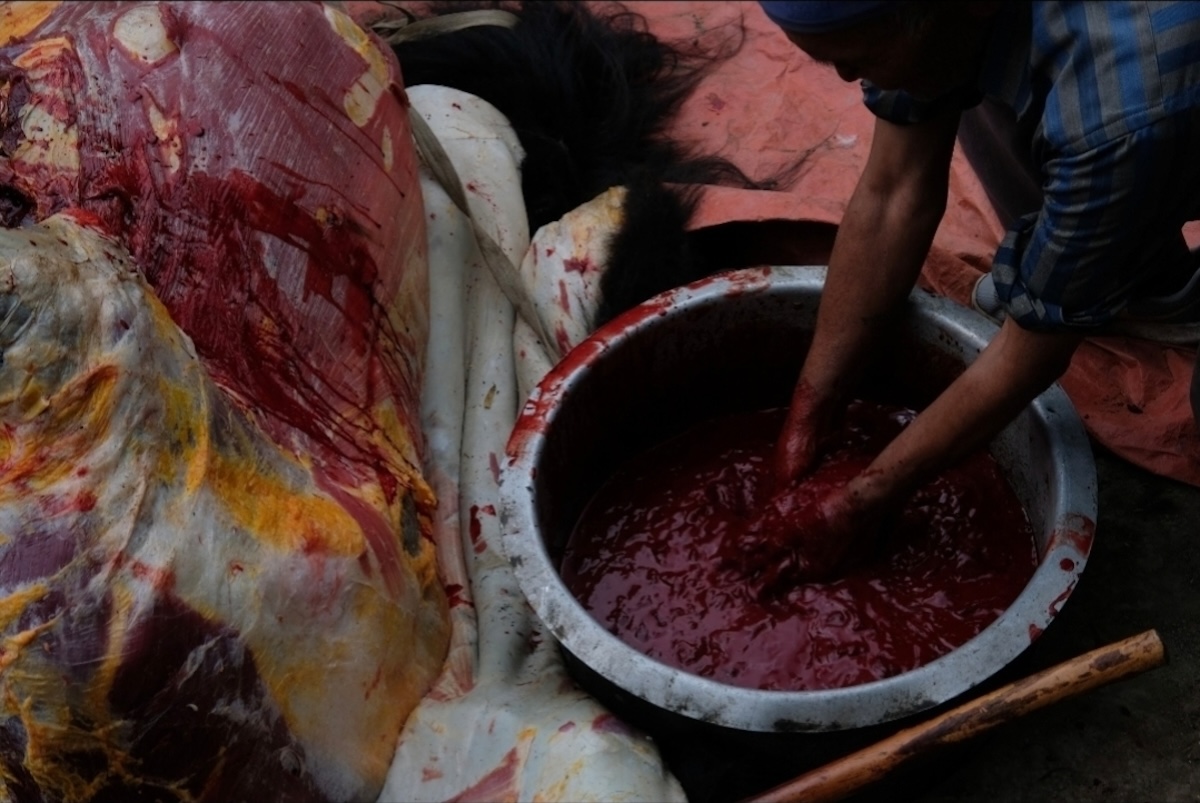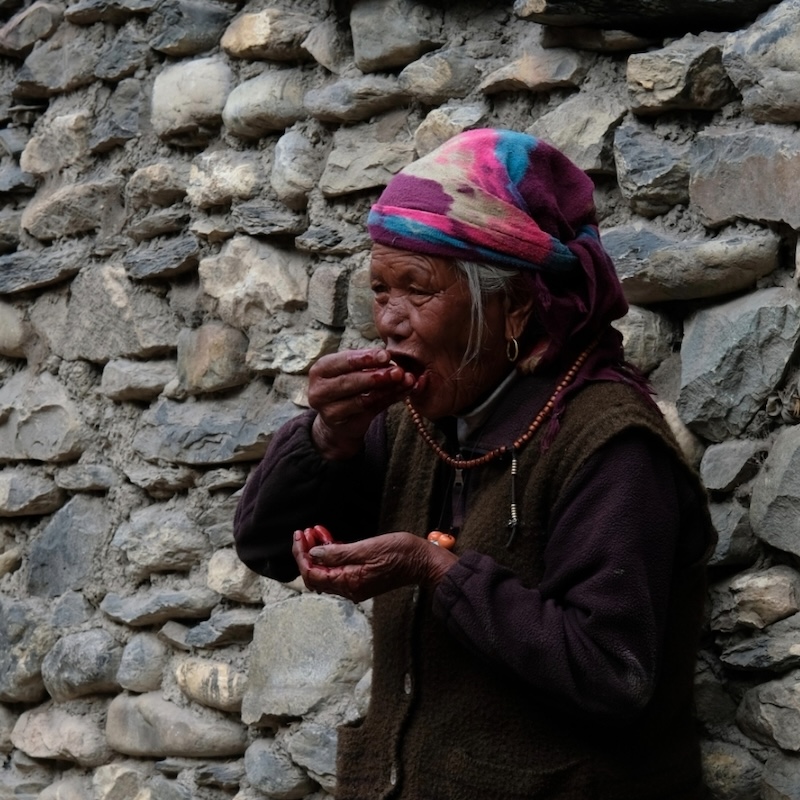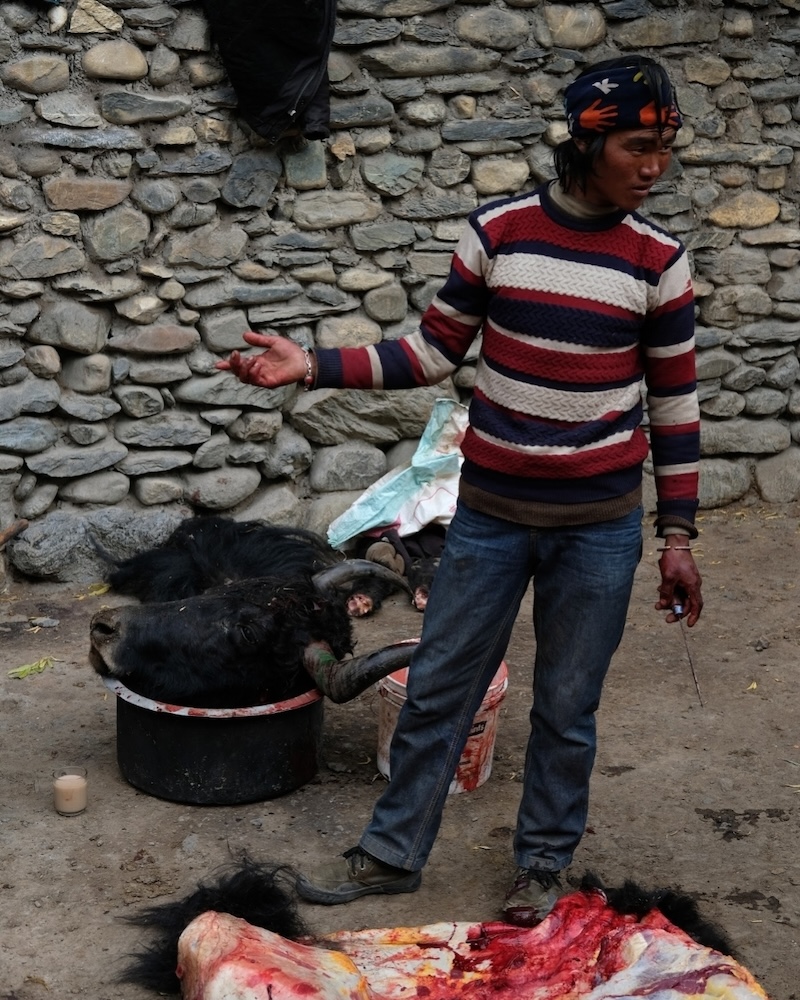Deep within Nepal, nestled against the Tibetan border, five Nepali men stood over a hobbled yak in a stone corral. I watched from my second-story room in the overlooking guest house. The beast struggled on its side, its horns cutting the dirt as its head violently swung back and forth. After about fifteen seconds, everything went silent, and the slaughterer pulled a ten-inch Kukri sword from its heart. Staggered by the events, I grabbed my camera, bribery cigarettes, and ran to the action.
Peering over the stone wall, I snapped photos, though the camera shutter felt intrusive and inappropriate. With a smile, the oldest man in the corral saw my curiosity and waved me in. “Namaste,” I said while ducking under the wooden door frame. Again, the man smiled in response, this time pointing to the yak, mimicking a pushing motion. He wanted to flip the yak on its back, and it was all hands on deck to budge the brute.
I continued to ask questions in English while rocking the animal as if it were a car stuck in snow, but with no response. They either couldn’t speak English or pretended not to, hoping I would go silent so they could work in peace. In any case, I couldn’t pass up the opportunity to make a joke when a neighbor’s cow ran into the corral by accident. I looked at the youngest butcher, threw my arms up, and yelled AHHHHHHH, pretending to be the horrified cow.
The low-hanging fruit of a joke seemed to bust up any tension among us, and they began to work. The slaughter of a yak may be rare, but this certainly wasn’t their first rodeo. In unison, the men removed the hooves, set them aside, and ran a blade from bow to stern. With the skin now bisected, one of the Nepali pulled out a piece of webbing and fed it through slits in the hide.
They pulled on the skin using the straps as grips while another man struck the woolly pelt with the backside of the hatchet. Inch by inch, he chopped the hide from the lifeless carcass. The rhythmic swinging of the axe ended abruptly, and one man snipped a piece of wool from the hide. He then fed the eight inches of black hair through a knitting-sized needle and began to stitch the meat afflicted by the mortal wound caused by the Kukri. It was a strange practice, but the need for the needle was strictly utilitarian as they did not want any blood to spill onto the dirt.

Once the mini-surgery was complete, they began to slice. A rusty blade slit the abdominal wall open, and when it hit ribs they began to hack at the brisket ferociously. Bits of blood and muscle misted the workers as they fought to expose the organs.
With the internals now accessible, a small hand entered the cavity, and out came a mess of congealed blood. The old man smiled at me and popped the viscous mess into his mouth. The look on my face must have entertained him, as he was now smiling larger than ever with blood-stained teeth. He reached back down into the cavern of the yak and grabbed another handful, extending it in my direction. Feeling the peer pressure and not being one to turn down food, I obliged.
Still smiling with blood smeared across his face, he waited until I joined the club. It tastes just as you would think: hot and messy with a touch of iron. The roughly five gallons collected were to be mixed with the organs and stuffed back into the intestines to become sausage.

It was smooth sailing from this point on. The legs were separated from the carcass, and the workers assumed their respective roles. Each leg met its maker on the wooden tree stump used as a chopping block. With a cigarette dangling from his mouth, the man wielding a cleaver chopped each piece of meat into four sections. The finished cuts were laid carefully on the yak’s hide in four separate piles. Each mound represented one of the families participating in the slaughter.
Evenhandedness turned out to be the most contentious aspect of the day. Restricted by my camera viewfinder, I missed what set off the screaming. Leaning against the wall stood an old lady, unsatisfied with the meat in her pile. She barked at her husband while holding a mound of congealed blood in her hand. Halfway through the argument, she reached down and ate a handful without pausing in her outburst. The argument became much more threatening as blood sprayed between her teeth in the direction of her marital adversary. The passionate scene eventually ended when the portions were equalized, again assuming the supervisor role.

The sun eventually hit its halfway mark in the sky, and it was time to rejoice. The post-mortem celebration was sparked with a cigarette. Smoked drained from their noses while smiling at the family members entering the corral, carrying food and a mysterious liquid.
Predictably, Nepalis crave only one dish called Dal Bhat, which consists of rice, lentil soup, curry, and, in this case, dried yak. Each simple ingredient stands alone on the plate and is combined when consumed. It’s unavoidable, flavorful, and hearty. Following tradition, I squatted down and began mixing the lentil soup into the rice with my fingers. The cheerful old man poured me a cup of cloudy liquid from the mystery thermos. “Raksi,” he shouted while motioning for me to drink. I took a sip and damn-near fell off my imaginary horse as the homemade booze torched my insides. I assume the lingering yak spirit felt some form of justice.
With most of the work behind us, we moved on to less-attractive jobs. This included cleaning the intestines in a creek nearby, throwing some yak bits to the street dogs, and preparing the meat for transport. One family member at a time would enter the corral, load up a bamboo basket called a doko, and brace the weight of the haul on their foreheads with a plastic strap. Although it looks uncomfortable, the practice has proven itself with the hordes of porters who attack Mt. Everest annually.

The corral was now empty, the only evidence of what transpired was a feral cat gnawing on a piece of intestine in the corner.
Absolutely nothing considered edible was wasted. The organs, blood, meat, bones, hide, and head had all been hauled to their respective houses. I shook hands with the butchers, thanking each one of them. The last person I thanked was the old man. He looked back and answered with that familiar smile. Although the rice wine had washed the blood from his teeth, his grin remained a beacon of happiness on this day of death.
These Nepalis living in one of the world’s most remote regions have lessons for all of us hunters. Butchering the year’s meat should be a family affair, full of laughter, food, and possibly hooch. The old lady who looked like Dracula reminds us that greed has no place on the cutting table. And when in doubt, take a cleaver or machete to large muscle groups to ensure the bone stays out of the trash can. Meat has meant life for the human species and the late yak proves this sentiment belongs to every culture, including the Buddhist.
Read the full article here

